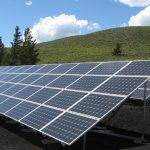A meeting was held on Tuesday, June 11 at the Hamilton Community Center regarding the rezoning of approximately 25 acres in Hamilton from agriculture to business for the purpose of making solar energy available to more people. The project is being proposed by Abe Huls and is called Sunny Hill Solar. The acreage is located in the Windy Hills area of Hamilton and the project will also require a special use permit, according to Huls. The meeting was to explain the project to interested citizens, and Mayor Casey was also in attendance.
According to the fact sheet distributed at the meeting, this proposal is a “way for households to utilize solar power that either rent or do not have adequate space for panels.” The sheet also proposes that the project will “allow approximately 800 low-income households to utilize solar power savings,” and that it will save eligible households 50% on the cost of electricity.
A chart accompanied the fact sheet showing the maximum income for households to be eligible for the Illinois Solar for All program. To be eligible, for instance, a family of four’s maximum gross income would be $60,700. The chart shows the gross income points for a single person ($42,500) up to a family of eight ($80,150). They would also need to reside in an Ameren utility service area.
Huls commented in an email that, “There were some concerns (mainly questions) on the scope of the project. Once we addressed there concerns and how to mitigate them, they [those who attended the meeting] were all fully on board.”
Other particulars that are on the fact sheet include: “No fees to sign up and can cancel anytime”; Pollinator blend to be planted throughout the facility to accommodate any beekeepers wanting to house hives on the site”; “Green screen on 400 yards of road frontage.” Other factors that were brought out include the intent to employ local contractors, that there will be a 6-foot fence around it, and that it would generate approximately $40,000 in annual property taxes for the community.
Huls is looking for a time frame of about four to eight months for the project to be up and running once it is approved, which could take a year or two.
This post was originally published on 3rd party site mentioned in the title of this site





